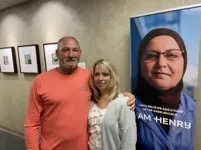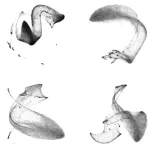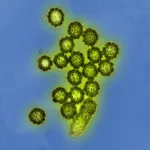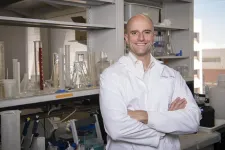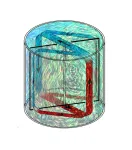Retired painting contractor Fred Casciano, 60, from Traverse City, became the first patient anywhere to receive the life-changing transcatheter procedure on April 12 at Henry Ford Hospital in Detroit. The procedure was re-engineered from an operation first developed in the 1950s.
“This new procedure we specifically engineered for Fred has never been done before but it replicates a bypass operation performed in the 1950s,” said Dr. O’Neill, director of the Henry Ford Center for Structural Heart Disease. “It opens the door for non-surgical treatment of thousands of patients who cannot have stents or open-heart revascularization procedures.” Each year, hundreds of thousands of patients are treated in the U.S. with coronary bypass surgery ― open heart ― or stent therapy through a cath lab procedure.
“Coronary revascularization has been a mainstay of therapy for coronary artery disease since the 1960’s,” said Dr. O’Neill.
Despite these available procedures, many patients are not able to receive the treatments because their coronary arteries are too small or too diseased to achieve effective bypass or stent procedures, he explained.
This medical challenge has led Henry Ford Health investigators to look back at the original operation developed decades ago. The original method required two operations and involved placing a bypass into the main vein in the heart known as the coronary sinus. The advantage of the operation was that the bypass was directed to the large disease-free vein. However, the original method also required two operations about a month apart. This risky method was later replaced by a safer coronary artery bypass procedure also known as coronary artery bypass graft (CABG) that became more common in the 1970s.
With this new procedure, Henry Ford Health cardiologists are optimistic about the possibility of positively impacting even more patients.
In Casciano’s case, Drs. O’Neill and Alaswad attempted to re-create the original operation without using the open-heart method. A channel between Casciano’s circumflex artery and his coronary sinus was successfully created during the cath lab procedure, and the channel is functioning well. Dr. O’Neill added that more testing will be done to assess how well the bypass is working.
“I trust Dr. O’Neill and Dr. Alaswad and their team with my life,” Casciano said just one day after the three-hour procedure. Before the Henry Ford cardiologists presented this as an option, Casciano had been told he out of traditional medical solutions and had just one working coronary artery left. “And that’s when Dr. O’Neill said, ‘We’re going to bring the blood in the back door because the front door is closed’.”
Following the successful bypass procedure and a one-day inpatient stay, Casciano returned home with his wife Annette to Northern Michigan, where he has been recovering and getting back to his busy daily routine.
“I don’t stop. I just keep going. I can’t sit still,” said Casciano, who’d initially traveled to Detroit in January to see Dr. O’Neill for any available possible treatments to fix his recurring blockages. Casciano has been under the watchful eye of Dr. O’Neill for years.
This wasn’t the first time Casciano received revolutionary treatment. In 2019, Casciano was one of only two patients in the U.S. to receive a coronary sinus reducer implant as part of a Food & Drug Administration (FDA) approved clinical trial led by Dr. O’Neill. A reduced blood flow in his heart had created the angina condition.
“My arteries couldn’t feed blood to the heart as fast as it was draining the blood through the veins, so they put a drainer restrictor in me,” recalled Casciano.
About two months after receiving the coronary sinus reducer, Casciano felt well enough to try a new bike trail that had opened up from Traverse City to Suttons Bay in northern Michigan. Thanks to the implant, he made the 35-mile roundtrip ride with no problems.
However, when his condition worsened last year, he once again reached out to Dr. O’Neill for answers.
Casciano’s coronary arteries previously treated with angioplasty and a stent had narrowed again. The condition known as in-stent restenosis is a blockage or narrowing that comes back in the portion of the coronary artery previously treated with a stent, where scar tissue forms inside the stent.
“Dr. O’Neill told us that we’re going to make an attempt to try something else and within a couple of weeks he had a plan,” said Casciano’s wife, Annette.
During the re-engineered procedure, Drs. Alaswad and O’Neill created a channel from the coronary artery to a vein to bypass the recurring and almost complete blockage that has continued to plague Casciano for much of his adult life. Casciano first experienced heart attacks at the age of 38 while working and was treated with angioplasty and a stent. At 41, he was diagnosed with 98% blockage of all major coronary arteries and underwent quintuple bypass surgery.
Unfortunately, a couple of months later, the blockage was back—and has continued to pose problems.
“It’s an exciting breakthrough that we hope will allow us to treat many more patients with this condition in the future,” said Dr. Alaswad, medical director of the Cardiac Catheterization Laboratory at Henry Ford Hospital in Detroit.
To learn more about Henry Ford Health’s Center for Structural Heart Disease, visit henryford.com/services/structural-heart.
###
MEDIA ONLY MAY CONTACT: Sal Giacona / sgiacon1@hfhs.org / 313-421-9108
ABOUT HENRY FORD HEALTH
Serving communities across Michigan and beyond, Henry Ford Health is committed to partnering with patients and members along their entire health journey. Henry Ford Health provides a full continuum of services – from primary and preventative care, to complex and specialty care, health insurance, a full suite of home health offerings, virtual care, pharmacy, eye care and other healthcare retail.
It is one of the nation’s leading academic medical centers, recognized for clinical excellence in cancer care, cardiology and cardiovascular surgery, neurology and neurosurgery, orthopedics and sports medicine, and multi-organ transplants. Consistently ranked among the top five NIH-funded institutions in Michigan, Henry Ford Health engages in more than 2,000 research projects annually. Equally committed to educating the next generation of health professionals, Henry Ford Health trains more than 4,000 medical students, residents and fellows every year across 50+ accredited programs.
With more than 33,000 valued team members, Henry Ford Health is also among Michigan’s largest and most diverse employers, including nearly 6,000 physicians and researchers from the Henry Ford Medical Group, Henry Ford Physician Network and Jackson Health Network.
The health system is led by President and CEO Robert G. Riney and serves a growing number of customers across 250+ locations throughout Michigan including five acute care hospitals, two destination facilities for complex cancer and orthopedics and sports medicine care, three behavioral health facilities, primary care and urgent care centers.
END
